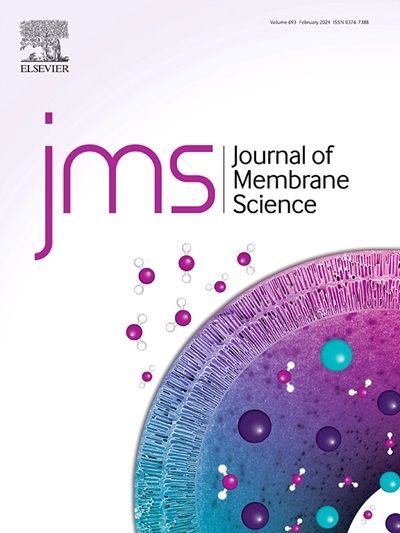Biomimetic, antibiofouling graphdiyne-Ti3C2Tx MXene fiber fabrics for high-performance osmotic energy conversion
IF 8.4
1区 工程技术
Q1 ENGINEERING, CHEMICAL
引用次数: 0
Abstract
Construction of advanced permselective membranes with strong surface charges, crosslinked hierarchical channels, and antibiofouling properties are needed to achieve high power density for harvesting sustainable osmotic energy in the marine environment. Herein, a biomimetic graphdiyne (GDY)-Ti3C2Tx MXene fiber fabrics (G-MFFs) with excellent ion permeability and selectivity based on a microfluidic wet-fused spinning and in situ polymerization strategy is reported. The decorated GDY improves antierosion quality and ion diffusion/rectification. The as-prepared G-MFFs with abundant ion migration channels and strong cation permselectivity exhibit increased Na+ ion diffusion capability (0.38 vs. 0.80 eV of MFFs) and a high transference number of Na+ ion. Therefore, the biomimetic permselective fabrics achieve a peak power density of 9.29 W m−2 in natural seawater/river water and 74.55 W m−2 under a 500-fold salinity gradient, far exceeding commercial standards. G-MFFs exhibit a promising long-term stability, high output power density with tunable fiber diameters and effective performance even under different pH levels (7.21–8.52 W m−2 at pH 4–10). Moreover, G-MFFs exhibit exceptional resistance against biofouling (an antimicrobial rate of 99.96 %). Hence, this study may inspire the fabrication and expand the viability of functional fabric-based permselective devices for practical marine environment applications.

求助全文
约1分钟内获得全文
求助全文
来源期刊

Journal of Membrane Science
工程技术-高分子科学
CiteScore
17.10
自引率
17.90%
发文量
1031
审稿时长
2.5 months
期刊介绍:
The Journal of Membrane Science is a publication that focuses on membrane systems and is aimed at academic and industrial chemists, chemical engineers, materials scientists, and membranologists. It publishes original research and reviews on various aspects of membrane transport, membrane formation/structure, fouling, module/process design, and processes/applications. The journal primarily focuses on the structure, function, and performance of non-biological membranes but also includes papers that relate to biological membranes. The Journal of Membrane Science publishes Full Text Papers, State-of-the-Art Reviews, Letters to the Editor, and Perspectives.
 求助内容:
求助内容: 应助结果提醒方式:
应助结果提醒方式:


